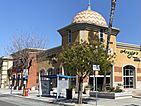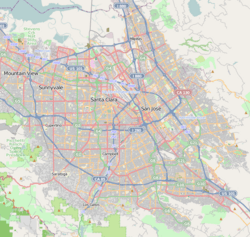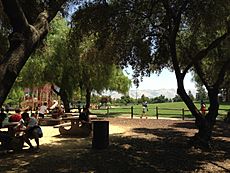- This page was last modified on 17 October 2025, at 10:18. Suggest an edit.
King & Story, San Jose facts for kids
|
King & Story
|
|
|---|---|
|
Neighborhood of San Jose
|
|
|
Top: shops at Plaza de San José, Mi Pueblo Plaza clocktower, Plaza de San José; middle: Plaza de Coatlique; bottom: intersection of King & Story, shops at La Placita Tropicana.
|
|
| Country | United States |
| State | California |
| County | Santa Clara |
| City | San Jose |
| Area code(s) | Area code 408 |
The King & Story neighborhood, also known as Story & King, is a well-known and historic area in San Jose, California. It's located in the Alum Rock district of East San Jose, centered around the intersection of King and Story roads. This neighborhood is especially important to the Chicano and Mexican-American communities in San Jose.
Contents
History of King & Story
The area around King and Story is a lively center for Latino culture in San Jose. Sometimes, the neighborhood is called Tropicana, named after a shopping center at the intersection.
In the 1930s, a famous leader named César Chávez and his family moved into this neighborhood. He later became a champion for farmworkers' rights. This is where Chávez first started helping people. He registered voters and organized English language classes for the many Mexican American residents. The first grocery stores that were part of the NFWA grape boycott were on King Road. This boycott was a way to protest for better pay and conditions for farmworkers.
In the 1980s, the area was famous for its lowrider cars. The Mural de la Raza, a large painting that shows Chicano history, was created on a wall near the intersection during that time. It is now one of the oldest murals in the city. The Mi Pueblo supermarket chain, which sells Hispanic foods, also started at this intersection.
Around the year 2000, the city worked to improve the area. They helped bring in new shops and banks, replacing old or empty buildings. In 2003, the San Jose City Council discussed renaming King Road after Martin Luther King Jr.. Some people supported this idea, especially the African American community. However, many in the Hispanic community did not agree. In the end, the city council decided not to change the road's name.
Culture in King & Story
King & Story is one of the most historic centers for the Chicano and Mexican-American community in San Jose.
Lowriding Culture
King and Story is often called the "Whittier Boulevard of the North." This is because it has many similar features to a famous street in East Los Angeles. You can often see lowriders cruising along King Road and Story Road.
Lowriding started in Los Angeles in the 1940s. By the 1960s, it became very popular in East San Jose's Chicano/Mexican-American community. It was especially common along wide streets like Alum Rock Avenue and Story Road. Lowrider magazine, which is all about these cool cars and the culture around them, was started in San Jose in 1977. It was founded by San Jose State students Larry González, Sonny Madrid, and David Núñez.
Today, lowrider culture is seen everywhere, from art to music and, of course, the cars themselves. Many car clubs in the South Bay still exist. They participate in events like Cinco de Mayo celebrations and "Show-n-Shine" car shows.
Parks and Plazas
- Emma Prusch Farm Park
- El Jardín Community Garden
- Cornucopia Community Garden
- Veggielution Community Farm
- Plaza de Coatlique
Images for kids
-
The Tula Sentries.













